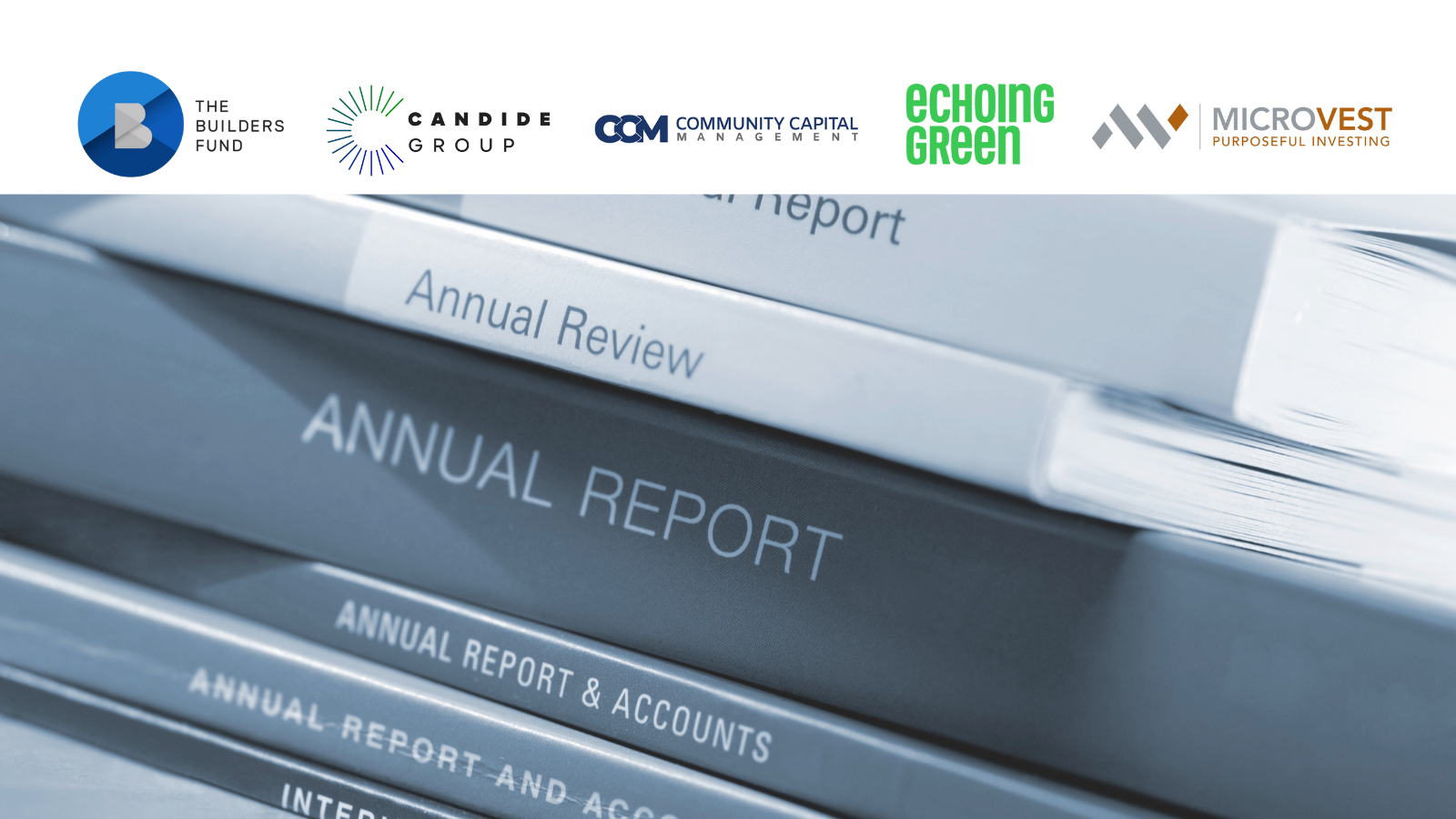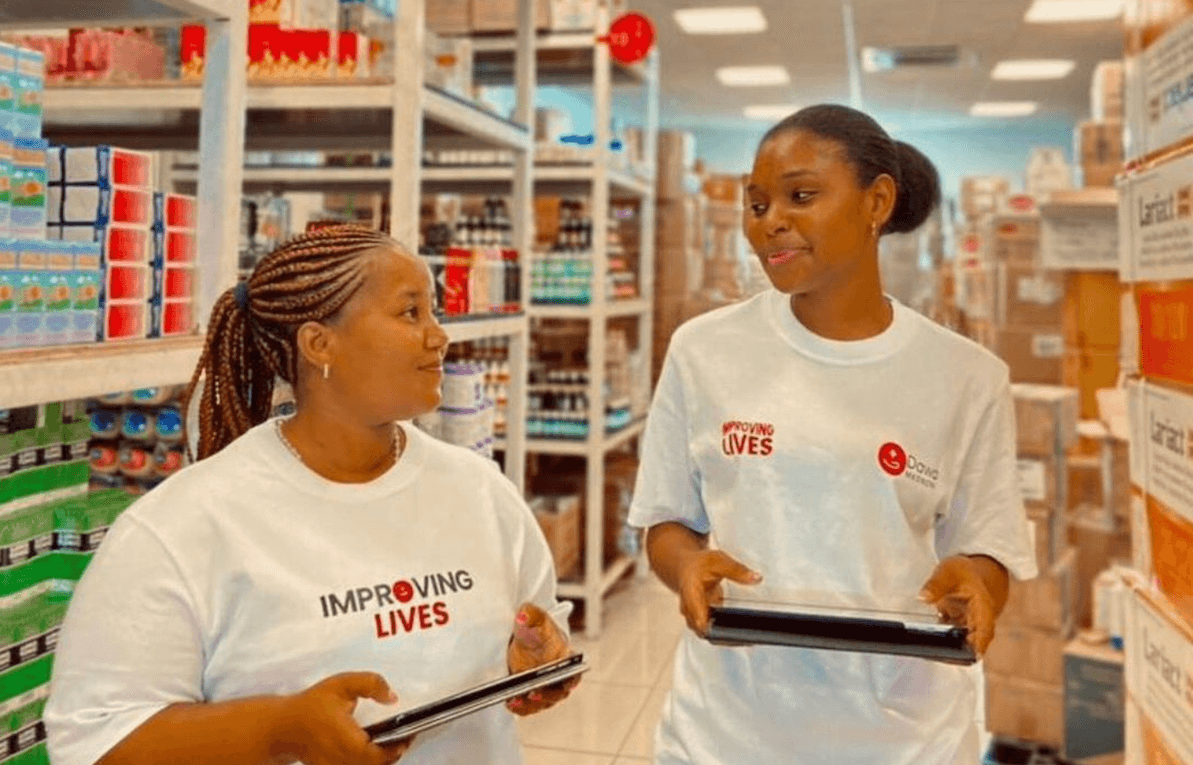ImpactAlpha, Feb. 6. 2023 – The age of ad hoc impact reporting may be coming to an end.
In the meantime, we’ve taken a swing through five very different annual impact reports from impact investors as diverse as Candide Group, an advisor to families, foundations and other investors; Microvest, a capital provider to microfinance and small-business lenders; and Echoing Green, a fellowship and social enterprise incubator with a specific focus on racial equity.
Rounding out this batch is Community Capital Management, the $4 billion advisor based in Florida, and Builders Fund, a $130 million small-cap buyout and growth capital private equity firm in San Francisco.
Last month’s roundup reviewed impact reports from Elevar Equity, Veris Wealth Partners, Atlas Impact Partners, Calvert Impact and Runway. Send us your impact report for next month’s roundup.
According to the Impact Frontiers collaboration, “Impact reports produced by investors vary significantly in the quality and scope of information covered and are often of limited use to investor stakeholders wanting to critically evaluate those reports for their own impact performance management purposes.”
In the coming months, Impact Frontiers will be working to build consensus around impact reporting, including by integrating various voluntary standards with the verification framework developed by BlueMark. BlueMark is testing that approach with seven fund managers participating in Impact Frontiers working groups.
BlueMark, a unit of the consultancy Tideline, assesses impact reports for completeness and reliability across four vectors of impact strategy and results and data clarity and quality. “BlueMark’s methodology does not go so far as to offer an opinion on whether a fund’s impact results are better or worse than those of other funds,” though the firm expects benchmarks to emerge over time.
ImpactAlpha is working with BlueMark to surface questions and concerns about impact report. Send us your questions about formats, frameworks, comparability, data sourcing and more and we’ll put them to BlueMark for an FAQ-style article.
Community Capital Management: Fixed-income and public-equities impact investing
Fun fact: Community Capital Management introduced the concept of “direct impact investing” in 2001, six years before Rockefeller Foundation coined “impact investing” as an industry-wide term for investments with the intention to generate both financial return and social or environmental impact.
But the Fort Lauderdale-based investment advisor wasn’t referring to direct impact investments in startups. Instead, CCM has pioneered an approach to impact through fixed-income investments, as well as public equity strategies. Its flagship impact bond fund, the CCM Community Impact Bond Fund, has grown to $3.2 billion in assets under management.
Through its fixed-income holdings, CCM in 2022 invested $308 million in 533 majority-minority census tracts, including 68 loans to low income minority borrowers and 40 to minority women borrowers, according to its 10th impact report.
As a sample investment, CCM invested $3 million last year in the Council of Europe Development Bank’s “social inclusion bond,” whose proceeds will be used to support Ukrainian refugees hosted by CEB member countries. CCM also invested in social bonds from the Minnesota Housing Finance Agency. Bond proceeds will be used to finance mortgages for first-time homebuyers from low- and middle-income Black, Indigenous, and people of color households.
In the latest report, CCM reviews its fixed-income impact strategy, including its work as a sub advisor to the Impact Shares Affordable Housing MBS ETF, which invests in mortgage-backed securities backed by pools of mortgage loans made to minority and low-income families.
Working with Redfin, CCM estimates that loans made from the portfolio holdings had generated an average wealth effect of approximately $44,000 per mortgage over the length of each loan’s investment period through August 3, 2022 (compared to a median family wealth of $36,100 for Hispanic Americans and $24,100 for Black Americans). CCM later this year will launch a fixed-income racial justice strategy with investment research firm Activest.
CCM invests across 18 different themes, including affordable housing, creative economy and sustainable agriculture, but tracks them all against measurable societal benefit as a result of CCM investor capital.
For fixed-income investments, CCM must have a high degree of certainty that the use of proceeds will have positive societal benefit. For public equities, it characterizes the holdings by the level of positive impact (strong = more than 50% of revenue is derived by an impactful product). The firm engages management through proxy voting to move the holdings along the continuum.
Bonus: The CCM impact report includes a handy glossary of terms including definitions for impact investing, mission-related investing and faith-based investing.
Candide Group: Shifting power and interrogating impact investing
Candide Group approached its first comprehensive impact report the way it approaches investment: by centering its investees and keenly examining nuances potentially overlooked by standard impact measurement frameworks.
Candide’s 2022 report gave investees leeway in what metrics they highlight. Elevating the leadership of historically marginalized individuals and creating high quality jobs for such individuals were the two most prioritized outcomes among investees. Investee HCAP Partners, for example, helps its portfolio companies identify opportunities to enhance job quality using its Gainful Jobs Approach.
“There is no universal framework. There is no perfect list of indicators,” notes Candide’s Jasmine Rashid. “Impact measurement is an opportunity to interrogate impact investing practices from all angles, and is a critical component of how we hold ourselves accountable to communities.”
Some of the questions Candide asked itself: “Are we investing in people who consider their social and environmental effects at all levels of business, or just outcomes? Does the way in which we collect data reinforce historical power dynamics between financiers and entrepreneurs, or does it build bridges for more equitable, dynamic relationships? Are we sharing impact insights as marketing materials for financial intermediaries, or as evidence of what’s possible when we center the frontline communities driving social change?”
Candide breaks down its impact into eight dimensions, ranging from the ownership and leadership of its investees to the end-users they serve and where they source from. Candide also looks at the additionality of its work.
More than half of Candide’s investees count Black, Indigenous, and/or people of color among their founders; at least 58% have BIPOC representation in ownership (not all investees responded). More than three-quarters of investees serve economically disadvantaged communities with their products and services.
Some highlights: Candide completed the allocation of its $40 million Olamina Fund and began fundraising for a Climate Justice Fund targeted at $50 million. It won a multi-year legal battle against private prison giant CoreCivic. To date, the registered investment advisor has directed more $200 million to more than 110 companies, including Tanka, Red Bay Coffee and Navajo Power. Fund investments include Thousand Currents and Seed Commons. The report covers 83 investments made before October 2022.
Candide’s internal impact levers include shifting power to communities (its Olamina and forthcoming Climate Justice funds take guidance from community advisory boards), and equitable personnel policies (if excess cash is tight, for example, Candide’s lowest paid employees get priority from the bonus pool). External considerations include providing flexible and catalytic capital and hands-on assistance. For example, Candide helped design “perpetual purpose trust” structures for Organically Grown and Firebrand.
Builders Fund: Buyout and growth capital for impact enterprises
Builders Fund made the first investment from its second fund in Posigen, a New Orleans solar installer focused on making clean energy affordable and accessible to low-income homeowners and communities. Nine months later, Hurricane Ida devastated a swath of southern Louisiana with Category 4 winds. Posigen teamed with the nonprofit Footprint Coalition to equip a dozen disaster response centers with solar power for lights, refrigerators and cell phone charging.
In its 2022 impact report, the fund said it is “particularly inspired” by Posigen’s work “to democratize access to clean energy, reduce energy use, build clean distributed energy networks; while also creating jobs and saving real money for low-to moderate income Americans.”
San Francisco-based Builders Fund, with $130 million total assets under management, operates in a niche of the growth capital market, writing checks of $5 million to $20 million for cash flow-positive companies with up to $100 million in revenues. That’s smaller than private-equity giants like TPG, KKR and Bain, but later-stage than venture firms like DBL Investors or SJF Ventures.
The firm’s first fund made four investments: the tea seller Traditional Medicinals; solar lantern maker MPOWERD; Mixt, the fast-casual salad chain; and fresh local food provider Urban Remedy. Each fund has a 14-year time horizon for “more exit flexibility” than the typical 10-year fund.
For the year, Builders Fund tallied 137 jobs created across its portfolio, including 70 for low- and moderate-income individuals. It counts 132,000 tons of carbon inset, avoided or reduced through operations, along with 1,300 tons of material diverted from landfills, among nearly two dozen key performance indicators.
Builders Fund itself is a certified B Corp, along with four of its portfolio companies (Posigen’s certification is pending). Since raising Fund II, Builders Fund tracks quarterly updates from the portfolio with the Proof of Impact dashboard. It categorizes its impact using the “ABC” classification system developed by the IMP+ACT Alliance, as well as by the U.N.’s Sustainable Development Goals.
“We remain inspired by the example of our impact investing peers, and by the purpose-driven work of our portfolio companies,” Builders Fund’s Tripp Baird told ImpactAlpha in an email. “We’re excited to lean into our our mission of Investing to Build a Better World (and to begin prepping for Fund III in the back half of this year).”
Echoing Green: Seed investments to advance racial equity
Echoing Green for 35 years has nurtured social entrepreneurs through its fellowship and leadership development programs. In 2020, the nonprofit set a four-year impact plan centered on advancing racial equity around the world, with the help of its $75 million Racial Equity Philanthropic Fund.
Echoing Green set a goal to launch and scale 520 racial equity-focused social enterprises around the world. At the midway mark, the nonprofit reports it’s about a third of the way there, having made seed or follow-on investments in more than 130 social enterprises across 40 countries.
The nonprofit has reached 2,215 leaders through its racial justice programming and workshops, nearly halfway towards its goal of cultivating 5,000 leaders who approach social change through racial justice frameworks.
A third goal focused on engaging 10,000 corporate employees to help them advance racial equity within their organizations. To date, it has connected 7,000 employees with social entrepreneurs through workshops and other engagements.
Another highlight: Echoing Green in 2022 saw the debut of its first documentary, Unwavering: The Power of Black Innovation, which explores the perseverance of Black innovators despite chronic underfunding.
Since its founding in 1987, Echoing Green has channeled $54 million to 900 entrepreneurs in 86 countries. These fellows have gone on to raise a total of $7.5 billion in additional funds; 70% are still in business. Echoing Green’s work is supported by donations from dozens of corporations and charitable groups, including 26 entities that gave more than $500,000 each.
MicroVest: Providing capital for financial inclusion at scale
Fourteen months ago, microfinance lender MicroVest announced that it was being acquired by international development advisory firm DAI. MicroVest’s assets under management had been in decline since 2017.
The goal: to secure “a capital budget to systematically think about how we scale this business,” MicroVest’s Gil Crawford told ImpactAlpha at the time.
The acquisition didn’t have an immediate impact on MicroVest’s growth, but the firm went on an investment sprint in December, deploying $63 million of the total $149 million invested in 2022, according to its latest impact report. Its capital supported 20 financial institutions in 14 countries.
MicroVest’s eye for growth shows up in the data of where it invested: 50% of its capital went to Latin America, where institutions cut much larger checks on average than any other region. Its end-borrower demographics are also growing: Microfinance borrowers in MicroVest’s portfolio companies increased 14% (to almost 800,000) while small business borrowers, which take on bigger loans, more than doubled (to roughly 157,000).
Gender lens. More than half (53%) of MircoVest’s portfolio companies’ borrowers are women. Women generally secure smaller investments than men: they compose more than 60% of microfinance borrowers but just over a third of small business borrowers.
Its portfolio companies also have higher than average representation of women in senior management and on boards: 25% and 19% respectively.
Digital transformation. Microfinance institutions, long traditional brick-and-mortar organizations, have lagged other segments of finance in tech adoption. There are benefits to the in-person approach: MicroVest claims MFIs still currently charge vastly lower interest rates than fintech ventures, despite tech’s presumed underwriting efficiency and cost-effectiveness, and they’re better able to reach more remote, offline customers.
Microfinance institutions are increasingly realizing that “software and data can play a significant role in reducing barriers to financial products for low-income households and [small businesses],” states MicroVest impact report.
MicroVest is helping its borrowers develop new products. Annapurna Finance in India, for example, is using geolocation data to develop financing to help borrowers mitigate against climate-related impacts.











